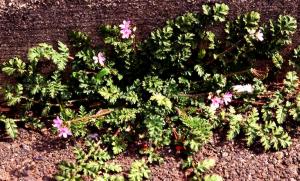CONTENTS
Registered Herbicides
[Return to weed
Identification]
[Return to Weed
Management]
[Home] |
|

General Description:
- shallow taproot with secondary fibrous roots.
- spreading or erect generally from a rosette.
- stems are 1 inch to 2 feet long.
- leaves are divided into narrow feather-like lobed or
toothed segments.
- leaves and stems are hairy and may have a reddish
color.
- flowers are purplish-pink and are generally in
clusters of 2 or more.
- the fruit is five lobed and long-beaked, with each
lobe splitting away at maturity.
Life cycle: winter annual or biennial
- reproduces by seed.
- germinates early spring through late summer.
- flowers in early spring or early summer ( may produce
flowers in summer).
Habitat/ Crops associated with:
- prefers dry, sandy soil.
- found in many perennial horticultural crops,
turfgrass, and landscapes.
- wheat, mint.
- native to Europe or Asia.
- common worldwide.
- has been grown for forages.
- considered a noxious weed only when it crowds out more
valuable crops.
- also known as storksbill.
Herbicide Control Notes:
- Gramoxone plus Goal usually most effective. When
filaree is small, Gramoxone plus Sinbar also is effective.
|